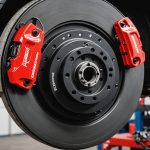Your classic British sports car deserves the best. A well-adjusted handbrake is essential for both safety and performance. Whether you're a seasoned enthusiast or a beginner, mastering this adjustment can enhance your driving experience. This guide offers a clear, step-by-step approach to perfecting your handbrake, ensuring that your beloved vehicle handles gracefully and reliably. Say goodbye to slipping brakes and hello to confident drives! Let’s dive into the specifics that will bring out the best in your car.
Understanding the Handbrake System
The handbrake mechanics in classic British cars are a fascinating blend of simplicity and functionality. Typically, the handbrake is a mechanical lever system that applies tension to the brake cables, engaging the rear brakes to prevent the vehicle from moving when parked. This vital component ensures safety, especially on inclines, making it crucial to understand its operation and maintenance.
A properly adjusted handbrake is essential for optimal performance. If the handbrake is too loose, it may not hold the vehicle securely, posing a safety risk. Conversely, if it's too tight, it can cause unnecessary wear on the brake components. Regular checks and adjustments are necessary to maintain the right tension and ensure the handbrake functions correctly.
Common issues related to handbrake malfunction in classic British cars often include stretched or snapped cables, worn brake pads, and misalignment. These problems can lead to reduced braking efficiency or even complete failure of the handbrake system. Addressing these issues promptly is vital to maintaining the vehicle's safety and reliability.
In summary, understanding the handbrake mechanics of classic British cars involves recognising its importance, ensuring proper adjustment, and being aware of common malfunctions. Regular maintenance and timely repairs can significantly enhance the safety and longevity of your vehicle's handbrake system.
Tools Required for Adjustment
Adjusting the handbrake of a classic British car requires specific handbrake adjustment tools to ensure precision and safety. Having the right tools not only makes the job easier but also helps in achieving the correct tension for optimal performance.
Essential Tools
- Socket Set: A comprehensive socket set is crucial for loosening and tightening nuts and bolts associated with the handbrake system.
- Screwdrivers: Both flathead and Phillips screwdrivers are necessary for removing panels and accessing the handbrake mechanism.
- Pliers: Useful for gripping and manipulating cables during adjustments.
- Torque Wrench: Ensures that bolts are tightened to the manufacturer's specified torque, preventing over-tightening.
Tool Recommendations
When selecting car maintenance tools, consider well-known brands like Snap-on or Craftsman, known for their durability and reliability. Investing in high-quality tools can save time and effort in the long run.
Safety Gear
Safety should always be a priority. Essential safety gear includes:
- Gloves: Protects hands from sharp edges and hot surfaces.
- Safety Glasses: Shields eyes from debris and dust.
- Jack Stands: Ensures the vehicle remains stable and secure while you work underneath.
Having the right handbrake adjustment tools and safety gear is fundamental to performing effective and safe car maintenance.
Step-by-Step Guide to Adjusting the Handbrake
Adjusting the handbrake in classic British cars is a crucial part of DIY car maintenance. This guide provides a comprehensive overview of the handbrake adjustment process, ensuring your vehicle remains safe and reliable.
Preparing the Vehicle
Before beginning the handbrake adjustment process, ensure the vehicle is on a flat, stable surface. Use jack stands to lift the rear wheels off the ground securely. Engage the main brake and place wheel chocks at the front wheels for added safety. This positioning is essential to prevent any unintended movement during the adjustment.
Adjusting the Handbrake Tension
Locate the handbrake cable under the car. Use a socket set to loosen the adjuster nuts slightly. Gradually tighten the nuts while checking the tension by pulling the handbrake lever inside the car. The lever should engage fully after four to six clicks. Avoid over-tightening, as this can cause brake drag.
Testing the Handbrake Functionality
Once the handbrake tension is adjusted, it's crucial to test its effectiveness. Lower the car back onto the ground and disengage the main brake. Attempt to push the car gently; it should remain stationary if the adjustment is correct. If the car moves, repeat the handbrake adjustment process until the desired tension is achieved.
Troubleshooting Common Handbrake Problems
When it comes to handbrake troubleshooting, recognising the symptoms of a faulty handbrake is the first step in addressing car repair issues effectively. Common indicators include a loose handbrake lever, unusual noises when engaging the brake, or the vehicle failing to remain stationary on an incline.
Identifying Symptoms
- Loose Lever: If the handbrake lever feels slack, it might indicate a stretched or snapped cable.
- Unusual Noises: Grinding or squeaking sounds could point to worn brake pads or misaligned components.
- Ineffective Braking: If the vehicle rolls despite the handbrake being engaged, the system may require adjustment.
Diagnosing Handbrake Problems
Begin by inspecting the handbrake cables for visible wear or damage. Next, check the brake pads and discs for signs of wear. If these components appear intact, examine the adjustment mechanism for any misalignment or obstructions.
Solutions for Common Issues
- Cable Replacement: For stretched or broken cables, replacing them is essential to restore functionality.
- Brake Pad Replacement: Worn pads should be replaced to ensure effective braking.
- Adjustment: Realigning the adjustment mechanism can resolve issues with tension and lever engagement.
By systematically addressing these car repair issues, you can ensure your handbrake remains reliable and effective.
Safety Precautions During Adjustment
Ensuring car safety during handbrake adjustment is paramount. Adhering to recommended safety practices can prevent accidents and injuries. Before you start any car maintenance, it's crucial to prepare adequately and follow a safety checklist.
Importance of Safety Measures
When working on handbrake adjustment, it's essential to prioritise safety. This involves using the correct tools and equipment, such as jack stands and wheel chocks. These tools ensure the vehicle remains stable, reducing the risk of unintended movement. Always work on a flat surface to maintain balance and control.
Recommended Practices
To avoid accidents, wear appropriate safety gear, including gloves and safety glasses. This gear protects against sharp edges and debris. Ensure the vehicle is securely lifted before starting any adjustments. Double-check that the main brake is engaged and the wheels are chocked to prevent rolling.
Safety Precautions Checklist
- Verify the vehicle is on a stable surface.
- Use jack stands to support the car securely.
- Place wheel chocks at the front wheels.
- Wear protective gloves and safety glasses.
- Ensure all tools are in good condition and within reach.
By following these handbrake adjustment safety measures, you can perform maintenance effectively while minimising risks.
Maintenance Tips for Long-Term Performance
Ensuring the longevity and effectiveness of your vehicle's handbrake is vital for safety and performance. Regular handbrake maintenance is key to preventing malfunctions and costly repairs.
Regular Checks
Perform routine inspections of your handbrake components. Check for signs of wear, such as frayed cables or worn brake pads. Regularly test the handbrake's effectiveness by engaging it on a slight incline to ensure it holds the vehicle securely. If the handbrake feels loose or requires excessive force to engage, it may need adjustment.
Maintenance Tips
To maintain optimal performance, lubricate the handbrake mechanism periodically to prevent rust and ensure smooth operation. Replace worn components promptly to avoid further damage. Keep the area around the handbrake clean and free of debris that could interfere with its function.
Signs of Needed Adjustment or Repair
Be vigilant for indicators that your handbrake requires attention. A handbrake lever that pulls up too easily or makes unusual noises might signal the need for adjustment. If the vehicle rolls despite the handbrake being engaged, inspect the system for potential issues. Addressing these signs early can prevent more serious problems and ensure your vehicle remains safe and reliable.
Illustrative Guide and Diagrams
Visual aids, such as handbrake adjustment illustrations and car repair diagrams, play a crucial role in car maintenance. They simplify complex processes, making them more accessible to enthusiasts and professionals alike. Understanding the mechanics of classic British sports cars can be challenging, but with the right diagrams, even intricate tasks become manageable.
Importance of Visual Aids
Visual aids help in breaking down the handbrake adjustment process into clear, manageable steps. They provide a visual reference that complements written instructions, ensuring that each step is executed correctly. This reduces the risk of errors and enhances the efficiency of the repair process.
Types of Diagrams
Several types of diagrams can assist in understanding the handbrake adjustment process. Exploded diagrams show components in detail, making it easier to identify parts and their connections. Step-by-step illustrations guide users through each phase of the adjustment, highlighting key actions and checkpoints.
Finding Reliable Illustrations
Reliable handbrake adjustment illustrations for classic British sports cars can be found in specialised repair manuals and enthusiast forums. These sources often provide high-quality diagrams tailored to specific models, ensuring accuracy and relevance. Accessing these resources can significantly improve your understanding and execution of car maintenance tasks.
Resources for Further Learning
For those passionate about classic car restoration, diving deeper into car maintenance resources can be incredibly rewarding. These resources not only enhance your knowledge but also connect you with a community of like-minded enthusiasts.
Recommended Books and Manuals
To start, several books and manuals are invaluable. Titles like "The Complete Guide to Classic Car Restoration" provide comprehensive insights into the nuances of classic car care. Haynes manuals, tailored to specific models, offer detailed instructions and diagrams, making them indispensable for hands-on enthusiasts.
Online Forums and Communities
Engaging with online forums is another excellent way to expand your knowledge. Platforms such as Classic Car Restoration Club and forums like The MG Experience provide spaces for enthusiasts to share advice, troubleshoot issues, and celebrate successes. These communities are invaluable for gaining insights and support from fellow classic car owners.
Workshops or Courses
For a more structured learning experience, consider enrolling in workshops or courses focused on car maintenance and restoration. Many automotive schools offer short courses that cover everything from basic maintenance to advanced restoration techniques. These courses provide hands-on experience and expert guidance, perfect for those looking to deepen their skills.
Conclusion and Recap of Key Points
In the realm of classic British sports car maintenance, understanding the intricacies of the handbrake adjustment process is crucial. This handbrake adjustment summary highlights the essential steps and considerations for enthusiasts keen on preserving their vehicles' performance and safety.
Engaging in regular car maintenance ensures that the handbrake remains effective, preventing potential safety hazards. Key takeaways include the importance of correctly adjusting the handbrake tension, which involves ensuring that the lever engages fully within the recommended clicks. Regular inspection of cables, brake pads, and the adjustment mechanism is vital to identify wear and misalignment early.
For those passionate about vehicle care, maintaining a classic car isn't just about functionality; it's an opportunity to connect with automotive history. Enthusiasts are encouraged to embrace this journey, armed with knowledge and the right tools. Regular checks and timely repairs not only enhance safety but also extend the vehicle's lifespan, preserving its legacy for future generations.
By actively engaging in car maintenance, owners can enjoy the satisfaction of a well-preserved classic car. This commitment to upkeep not only safeguards the vehicle but also enriches the driving experience, making it a rewarding pursuit for any classic car aficionado.










